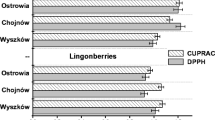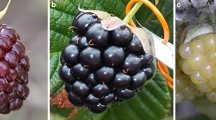Abstract
Highbush (cultivated) and lowbush (wild) are the two major blueberry species in the US market. Eight phenolic acids were detected and quantified from these two species by HPLC-MS. Chlorogenic acid was found to be the predominant phenolic acid in both species, with 0.44 mg/g fresh weight in lowbush blueberries and 0.13 mg/g fresh weight in highbush blueberries. Total phenolic content in lowbush blueberries is over three times higher than that of highbush blueberries. The phenolic acid mixtures representing those in the two species were prepared by using authentic standards to assess their contribution to total antioxidant and anti-inflammatory activities of the whole berries. Neither lowbush nor highbush blueberry phenolic acid mixture contributed significantly to the total antioxidant capacity of their relevant whole berries measured by oxygen radical absorbance capacity (ORAC). Both phenolic acid mixtures were able to enter the cell and showed in cell antioxidant activities from the cell based antioxidant protection of erythrocytes (CAP-e) assay. Lowbush blueberry phenolic acid mixture was found to show anti-inflammatory activities by inhibiting the nuclear factor-κB (NF-κB) activation and the production of inflammatory cytokines (TNF-α and IL-6) at the high dose.


Similar content being viewed by others
References
Ebadi M (2006) Blueberry (Vaccinium). In: Pharmacodynamic basis of herbal medicine. second edition edn. CRC Press Boca Raton, pp 209–211
Paredes-Lopez O, Cervantes-Ceja ML, Vigna-Perez M, Hernandez-Perez T (2010) Berries: improving human health and healthy aging, and promoting quality life–a review. Plant Foods Hum Nutr 65(3):299–308. doi:10.1007/s11130-010-0177-1
Szajdek A, Borowska EJ (2008) Bioactive compounds and health-promoting properties of berry fruits: a review. Plant Foods Hum Nutr 63(4):147–156. doi:10.1007/s11130-008-0097-5
Cheng A, Yan H, Han C, Wang W, Tian Y, Chen X (2014) Polyphenols from blueberries modulate inflammation cytokines in LPS-induced RAW264.7 macrophages. Int J Biol Macromol 69:382–387. doi:10.1016/j.ijbiomac.2014.05.071
Wu X, Beecher GR, Holden JM, Haytowitz DB, Gebhardt SE, Prior RL (2004) Lipophilic and hydrophilic antioxidant capacities of common foods in the United States. J Agric Food Chem 52(12):4026–4037. doi:10.1021/jf049696w
Basu A, Du M, Leyva MJ, Sanchez K, Betts NM, Wu M, Aston CE, Lyons TJ (2010) Blueberries decrease cardiovascular risk factors in obese men and women with metabolic syndrome. J Nutr 140(9):1582–1587. doi:10.3945/jn.110.124701
Kay CD, Holub BJ (2002) The effect of wild blueberry (Vaccinium angustifolium) consumption on postprandial serum antioxidant status in human subjects. Br J Nutr 88(4):389–398. doi:10.1079/bjn2002665
Blacker BC, Snyder SM, Eggett DL, Parker TL (2013) Consumption of blueberries with a high-carbohydrate, low-fat breakfast decreases postprandial serum markers of oxidation. Br J Nutr 109(9):1670–1677. doi:10.1017/s0007114512003650
Wu X, Kang J (2011) Blueberries: major phytochemicals and potential health effects in cardiovascular diseases berries: properties, consumption and nutrition. Nova Science Publishers
Rodriguez-Mateos A, Cifuentes-Gomez T, Tabatabaee S, Lecras C, Spencer JP (2012) Procyanidin, anthocyanin, and chlorogenic acid contents of highbush and lowbush blueberries. J Agric Food Chem 60(23):5772–5778. doi:10.1021/jf203812w
Manganaris GA, Goulas V, Vicente AR, Terry LA (2014) Berry antioxidants: small fruits providing large benefits. J Sci Food Agric 94(5):825–833. doi:10.1002/jsfa.6432
Pandey KB, Rizvi SI (2009) Plant polyphenols as dietary antioxidants in human health and disease. Oxidative Med Cell Longev 2(5):270–278. doi:10.4161/oxim.2.5.9498
Zheng W, Wang SY (2003) Oxygen radical absorbing capacity of phenolics in blueberries, cranberries, chokeberries, and lingonberries. J Agric Food Chem 51(2):502–509. doi:10.1021/jf020728u
Prior RL, Rogers TR, Khanal RC, Wilkes SE, Wu X, Howard LR (2010) Urinary excretion of phenolic acids in rats fed cranberry. J Agric Food Chem 58(7):3940–3949. doi:10.1021/jf9028392
Wu X, Pittman III HE, Hager T, Hager A, Howard L, Prior RL (2009) Phenolic acids in black raspberry and in the gastrointestinal tract of pigs following ingestion of black raspberry. Mol Nutr Food Res 53(Suppl 1):S76–S84. doi:10.1002/mnfr.200800231
Chen JR, Lazarenko OP, Wu X, Kang J, Blackburn ML, Shankar K, Badger TM, Ronis MJ (2010) Dietary-induced serum phenolic acids promote bone growth via p38 MAPK/beta-catenin canonical Wnt signaling. J Bone Miner Res 25(11):2399–2411. doi:10.1002/jbmr.137
Xie C, Kang J, Chen JR, Nagarajan S, Badger TM, Wu X (2011) Phenolic acids are in vivo atheroprotective compounds appearing in the serum of rats after blueberry consumption. J Agric Food Chem 59(18):10381–10387. doi:10.1021/jf2025264
Montales MT, Rahal OM, Kang J, Rogers TJ, Prior RL, Wu X, Simmen RC (2012) Repression of mammosphere formation of human breast cancer cells by soy isoflavone genistein and blueberry polyphenolic acids suggests diet-mediated targeting of cancer stem-like/progenitor cells. Carcinogenesis 33(3):652–660. doi:10.1093/carcin/bgr317
Laveti D, Kumar M, Hemalatha R, Sistla R, Naidu VG, Talla V, Verma V, Kaur N, Nagpal R (2013) Anti-inflammatory treatments for chronic diseases: a review. Inflamm Allergy Drug Targets 12(5):349–361
Honzel D, Carter SG, Redman KA, Schauss AG, Endres JR, Jensen GS (2008) Comparison of chemical and cell-based antioxidant methods for evaluation of foods and natural products: generating multifaceted data by parallel testing using erythrocytes and polymorphonuclear cells. J Agric Food Chem 56(18):8319–8325. doi:10.1021/jf800401d
Jensen GS, Wu X, Patterson KM, Barnes J, Carter SG, Scherwitz L, Beaman R, Endres JR, Schauss AG (2008) In vitro and in vivo antioxidant and anti-inflammatory capacities of an antioxidant-rich fruit and berry juice blend. Results of a pilot and randomized, double-blinded, placebo-controlled, crossover study. J Agric Food Chem 56(18):8326–8333. doi:10.1021/jf8016157
Kang J, Thakali KM, Xie C, Kondo M, Tong Y, Ou B, Jensen G, Medina MB, Schauss AG, Wu X (2012) Bioactivities of açaí (Euterpe precatoria Mart.) fruit pulp, superior antioxidant and anti-inflammatory properties to Euterpe oleracea Mart. Food Chem 133(3):671–677. doi:10.1016/j.foodchem.2012.01.048
Zadernowski R, Naczk M, Nesterowicz J (2005) Phenolic acid profiles in some small berries. J Agric Food Chem 53(6):2118–2124. doi:10.1021/jf040411p
Mattila P, Hellstrom J, Torronen R (2006) Phenolic acids in berries, fruits, and beverages. J Agric Food Chem 54(19):7193–7199. doi:10.1021/jf0615247
Scalzo J, Politi A, Pellegrini N, Mezzetti B, Battino M (2005) Plant genotype affects total antioxidant capacity and phenolic contents in fruit. Nutrition 21(2):207–213. doi:10.1016/j.nut.2004.03.025
Kang J, Li Z, Wu T, Jensen GS, Schauss AG, Wu X (2010) Anti-oxidant capacities of flavonoid compounds isolated from acai pulp (Euterpe oleracea Mart.). Food Chem 122(3):610–617. doi:10.1016/j.foodchem.2010.03.020
Niki E (2011) Antioxidant capacity: which capacity and how to assess it? J Berry Res 1(4):169–176. doi:10.3233/jbr-2011-018
Prior RL, Wu X, Schaich K (2005) Standardized methods for the determination of antioxidant capacity and phenolics in foods and dietary supplements. J Agric Food Chem 53(10):4290–4302. doi:10.1021/jf0502698
Prior RL, Gu L, Wu X, Jacob RA, Sotoudeh G, Kader AA, Cook RA (2007) Plasma antioxidant capacity changes following a meal as a measure of the ability of a food to alter in vivo antioxidant status. J Am Coll Nutr 26(2):170–181
Lopez-Alarcon C, Denicola A (2013) Evaluating the antioxidant capacity of natural products: a review on chemical and cellular-based assays. Anal Chim Acta 763:1–10. doi:10.1016/j.aca.2012.11.051
Chiva-Blanch G, Visioli F (2012) Polyphenols and health: moving beyond antioxidants. J Berry Res 2(2):63–71. doi:10.3233/jbr-2012-028
dos Santos MD, Almeida MC, Lopes NP, de Souza GE (2006) Evaluation of the anti-inflammatory, analgesic and antipyretic activities of the natural polyphenol chlorogenic acid. Biol Pharm Bull 29(11):2236–2240
Ruifeng G, Yunhe F, Zhengkai W, Ershun Z, Yimeng L, Minjun Y, Xiaojing S, Zhengtao Y, Naisheng Z (2014) Chlorogenic acid attenuates lipopolysaccharide-induced mice mastitis by suppressing TLR4-mediated NF-kappaB signaling pathway. Eur J Pharmacol 729C:54–58. doi:10.1016/j.ejphar.2014.01.015
Conflict of Interest
The authors declare that there is no conflict of interest.
Author information
Authors and Affiliations
Corresponding author
Additional information
This study was supported by USDA (6251-51000-005-02S).
Electronic Supplementary Material
Below is the link to the electronic supplementary material.
ESM 1
(DOC 155 kb)
Rights and permissions
About this article
Cite this article
Kang, J., Thakali, K.M., Jensen, G.S. et al. Phenolic Acids of the Two Major Blueberry Species in the US Market and Their Antioxidant and Anti-inflammatory Activities. Plant Foods Hum Nutr 70, 56–62 (2015). https://doi.org/10.1007/s11130-014-0461-6
Published:
Issue Date:
DOI: https://doi.org/10.1007/s11130-014-0461-6




